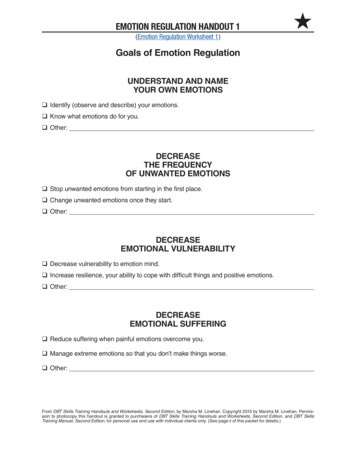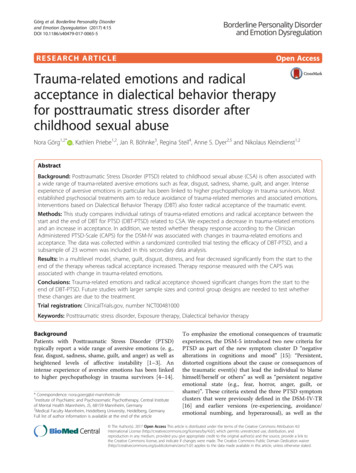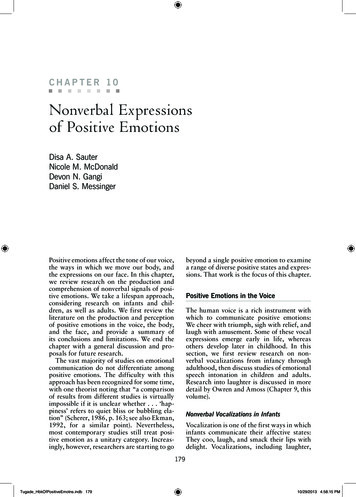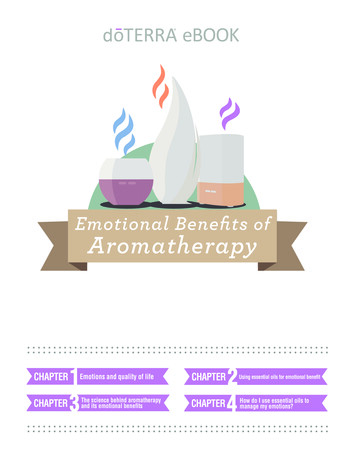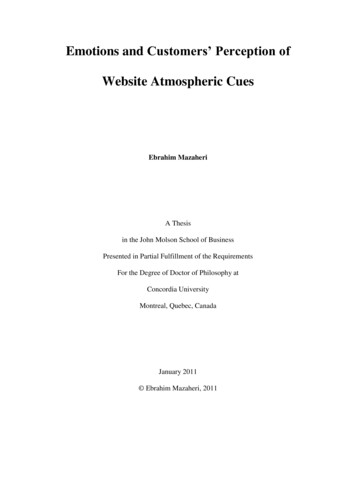
Transcription
Emotions and Customers’ Perception ofWebsite Atmospheric CuesEbrahim MazaheriA Thesisin the John Molson School of BusinessPresented in Partial Fulfillment of the RequirementsFor the Degree of Doctor of Philosophy atConcordia UniversityMontreal, Quebec, CanadaJanuary 2011 Ebrahim Mazaheri, 2011
CON CORD IA UN IVERSITYSCHOOL OF GRAD UATE STUD IESThis is to certify that the thesis preparedBy:Entitled :Ebrahim MazaheriEmotions and Customers’ Perception of Website Atmospheric Cuesand subm itted in partial fulfillm ent of the requirem ents for the d egree ofDOCTOR OF PH ILOSOPH Y (Business Ad m inistration)com plies w ith the regulations of the University and m eets the accepted stand ard s w ith respectto originality and quality.Signed by the final examining com mittee:ChairD r. M. Conw ayExternal Exam inerDr. B.J. BabinExternal to ProgramDr. W. Gard inerExam inerDr. M. PaulinExam inerDr. R. ToffoliThesis SupervisorDr. M. LarocheApproved byDr. H . Bhabra, Grad uate Program DirectorFebruary 15, 2011Dr. S. Sharma, DeanJohn Molson School of Business
ABSTRACTEmotions and Customers’ Perception of Website Atmospheric CuesEbrahim Mazaheri, Ph.D.Concordia University, 2011The primary purpose of this study was to develop a more comprehensive model ofonline consumer behaviour and test it in different industries to increase thegeneralizability of the results. This study used Zajonc (1980) theory of emotions andMehrabian and Russell (1974) Stimulus-Organism-Response (SOR) paradigm toexamine the relationships between customers’ emotions, perception of siteatmospheric and other behavioural and intentional variables. Based on Zajonc (1980)theory of emotions, it is proposed that customers’ emotions arise upon the initialexposure to the website, which in turn, influences their perception of site atmosphericcues such as site informativeness, site effectiveness, and site entertainment. Then,based on SOR paradigm, it is proposed that customers’ perceptions influence theirintentional and behavioural variables such as site attitudes, site involvement, productattitudes, and purchase intention. To increase the generalizability of the findings, theproposed model was tested in three studies. In addition, the path coefficients of all therelationships in the model were compared in those studies.First study tested and compared the path coefficients of all the relationships inthe model between physical goods and services websites. The results of multi-groupanalysis in EQS supported the overall model and demonstrated several non-invariantpaths between the two groups. Particularly, the results suggested that the influences ofpleasure and arousal on customers’ perception of site atmospheric cues are strongerfor physical goods customers and influences of site effectiveness on site attitudes andinformativeness are stronger for services customers.Page iii
Second study tested the model and compared the path invariance among threetypes of services: search-, experience-, and credence-based. The results, again,supported the overall model and revealed several non-invariant structural paths. Theresults suggested that the influences of “dominance” are the greatest for search-basedservices while “pleasure” impacts are greater for experience- and credence-basedservices.Third study tested the model and compared it between Canadian and Chinesecultures. The results supported the proposed model and demonstrated that half of thestructural paths are non-invariant between the two groups. Particularly, the impacts ofpleasure on perception of atmospheric cues are stronger for Canadian customers;whereas, dominance has greater influence on Chinese customers’ perception.Moreover, the impact of site entertainment on site attitudes and involvement arestronger for Chinese, while, site informativeness and effectiveness have greaterimpacts on Canadian customers.The contribution of this paper is twofold. First, it develops a morecomprehensive model of online consumer behaviour and suggests that customers’emotions at the initial exposure to the website are a driver of their site atmosphericperception. Second, it empirically tests the model in different industries and culturesand reports the differences across groups. Results of all the three studies supported theoverall model and revealed many non-invariant structural paths across groups. Thetheoretical and practical implications are discussed in each study.Page iv
ACKNOWLEDGEMENTSI would like to gratefully acknowledge supports of several individuals withoutwhom I would not have been able to come this far.I am very fortunate and honored to work with my supervisor, Dr. MichelLaroche, over the years. Michel’s flexibility, patience and support gave me freedomto explore on my own; while, he was a great guide when my steps faltered. Hisencouragement and commitments to my work was the greatest inspiration to gothrough the most significant academic challenges I have ever had.Dr. Michele Paulin, the internal committee member, has always been there tolisten and give advice. I am very grateful for the long discussions and valuablecomments of my work. Michele helped me to become a better lateral thinker.I would also like to thank my external committee members –Dr. Toffoli andDr. Babin –for accepting to be members of my dissertation committee. Theirprofessional guidance and support to this study has been invaluable. I hope ourcollaboration continues in future.During the years of my Ph.D. program, I had the privilege of knowing andworking with great people. I would like to thank them all for making these years themost memorable years of my life.Most importantly, I would like to thank my wife Kajal. Her support,encouragement, patience, and love enabled me to overcome all the challenges. I oweher not only for her unwavering support during the many days of my graduate studies,but also for being a great mom for our child, Ryan, who was born during my PhDprogram. I am very grateful to my wife’s family to be always there standing by ourPage v
side. Their unconditional love and true belief in us were great sources of emotionalsupport through our difficult times.Last, but not least, my parents deserve special acknowledgement for theirinseparable support and prayers. My father is the person who showed me the joy ofintellectual pursuit and has been my role model ever since I was a child. My mother isthe one who sincerely raised me with her caring and gentle love. Words fail to expressmy true appreciation to them.Page vi
Table of ContentsLIST OF TABLES . IXCHAPTER 1. INTRODUCTION.1CHAPTER 2. THEORETICAL BACKGROUND .52.1. EMOTIONS . 112.2. CUSTOMERS PERCEPTION OF SITE ATMOSPHERICS . 142.3. SITE ATTITUDES, SITE INVOLVEMENT AND ATTITUDES TOWARD THE PRODUCT . 172.4. ENTERTAINMENT . 19CHAPTER 3. STUDY 1: PHYSICAL GOODS VS SERVICES .213.1. METHODOLOGY. 263.1.1. Data Collection . 263.1.2. Measurement . 273.2. RESULTS. 273.2.1. Test of Reliability and Confirmatory Factor Analysis (CFA) . 273.2.2. Test of Proposed Model . 283.2.3. Results of the Multiple-Group Analyses . 293.3. SUMMARY OF FINDINGS . 303.4. CONCLUSION . 32CHAPTER 4. STUDY 2: SERVICE CLASSIFICATION .344.1. METHODOLOGY. 424.1.1. Site Selection and Data Collection . 424.1.2. Measurement . 444.2. RESULTS. 454.2.1. Manipulation check. 464.2.2. Test of Reliability and Confirmatory Factor Analysis (CFA) . 464.2.3. Test of the Proposed Model . 48
4.2.4. Invariance across Groups . 504.3. SUMMARY OF FINDINGS . 504.3. CONCLUSION . 54CHAPTER 5. STUDY3: ROLE OF CULTURE.575.1. METHODOLOGY. 635.1.1. Data Collection . 635.1.2. Measurement . 645.2. RESULTS. 655.2.1. Test of Reliability and Confirmatory Factor Analysis (CFA) . 655.2.2. Tests of the Proposed Model . 685.2.2. Invariance across Groups . 685.3. SUMMARY OF FINDINGS . 705.4. CONCLUSION . 71CHAPTER 6. OVERALL CONCLUSION .74CHAPTER 7. OVERALL LIMITATION AND FUTURE RESEARCH .78APPENDIX 1. LIST OF ITEMS AND RESULTS OF EFA FOR THREE STUDIES .88
LIST OF TABLESSTUDY 1:TABLE 1. CRONBACH’S ALPHA .27TABLE 2. TEST OF MEASUREMENT INVARIANCE BETWEEN PHYSICAL GOODS AND SERVICES .30STUDY2:TABLE 3. ITEMS FOR SERACH & EXPERIENCE PRODUCT EVALUATION .43TABLE 4. RESULTS OF CFA FOR SEARCH AND EXPERIENCE PRODUCT EVALUATION .45TABLE 5. RESULTS OF MANIPULATION CHECK .46TABLE 6. CRONBACH’S ALPHA .47TABLE 7. SQUARE ROOT OF THE AVE AND THE CORRELATIONS AMONG FACTORS .49TABLE8. RESULTS OF THE INVARIANCE TESTS OF THE MODEL ACROSS THE THREE TYPES OF SERVICES .52STUDY3:TABLE 9. HOFSTEDE SCORES FOR CANADA AND CHINA .58TABLE 10. PERCENTAGE OF PARTICIPANTS ASSIGNED TO EACH INDUSTRY .64TABLE 11. CRONBACH’S ALPHA .66TABLE 12. SQUARE ROOT OF THE AVE ARE AND CORRELATIONS AMONG FACTORS. .67TABLE 13. TEST OF MEASUREMENT INVARIANCE BETWEEN THE TWO GROUPS .69TABLE 14. RESULTS OF THE INVARIANCE TESTS OF THE MODEL BETWEEN THE TWO GROUPS .70ix
CHAPTER 1INTRODUCTIONDevelopment of e-commerce and the transition from traditional retailing toonline retailing has encouraged researchers to explore different aspects of the newmedium. Grewal and Levy (2009) stated that the use of the Internet by almost allcustomers and business segments have changed the retailing marketplacetremendously.In the traditional retailing context, Baker (1987) and Baker et al. (1994)suggested that store environment and atmospheric cues are more influential than othermarketing inputs that are not present at the point of purchase. In a review of literature,Turley and Milliman (2000) reported over 60 published articles that reportedsignificant associations between store atmospheric cues and consumer behaviorvariables (Dailey 2004).Previous studies in online store atmospherics investigated the influences ofcustomers’ perception of the site atmospheric cues on their intentions and behaviors.Majority of those studies relied on the Stimulus-Organism-Response (SOR)framework proposed by Mehrabian and Russell (1974) –which Mummalaneni (2005)confirmed its viability in online retailing. Richard (2005) assumed that onlineenvironmental cues were stimulus, customers’ cognitive and affective responses –such as site attitudes and site involvement –were organism, and shopping outcomeswere responses. She supported the model and concluded that online environmentalcues –such as site informativeness, structure, organization –influence purchaseintention through customers’ cognitive and affective responses. Similarly, Hausmanand Siekpe (2009) reported that online store atmospherics influence customers’Page 1
attitudes toward the website and flow, which in turn, impact purchase intention.Furthermore, Kim, Fiore, and Lee (2007) found that online store perception andonline shopping involvement influence customers’ desire to stay at the online storeand purchase intention.Emotion is known as one of the central element in understanding customerbehavior (Oliver, 1986; Bagozzi, Gopinath, and Nyer, 1999). Scholars in servicesmarketing and traditional retailing have demonstrated the significant influence ofcustomers’ emotions on their reactions to the service encounter and store environment(Donovan et al., 1994; Mattila and Enz, 2002; Pough, 2001). Despite the importanceof this topic in online retailing, very few studies have empirically investigated thecustomers’ affective responses to the online store atmospheric. Furthermore, thosestudies reported mixed results regarding the influences of emotional responses inonline shopping environment (i.e. Mummalaneni, 2005).Adopting the SOR framework, previous studies assumed that storeatmospheric cues are antecedent of customer’s emotions (Mummalaneni, 2005;Richard, 2005). While, research in Psychology suggests that individuals’ emotionalreactions precede their cognitive and perceptual operations (Zajonc, 1980). Thisresearch argues that customers need to use their cognition to evaluate, at least certain,store atmospheric cues. As a result, the relationship between customers’ emotionalreaction and customers’ perception of site atmospheric cues is a topic that requiresfurther exploration.This research aims to bridge the gap in the literature by empiricallyinvestigating the relationship between emotions and site atmospheric cues. For that, itcategorizes the atmospheric cues into two groups. First group influences customers’emotions at the initial exposure to the site. The second group consists of the cuesPage 2
which must be perceived by customers; thus, is the consequent of emotions. Based onthis categorization and SOR framework this research proposes a more comprehensivemodel of online customer behavior.In order to validate the proposed model and test the generalizability offindings, three studies are conducted. The intention is to explore the potentialmoderating effect of industries, service types, and culture on the relationships in theproposed model. It is important to test moderating effects as the post hoc modelmodification may be driven by characteristics of the particular sample (or industry) onwhich the model was tested (Byrne, 1994). Testing a model in different industries andculture addresses this issue and increase generalizability of the findings.The first study tests the proposed model in both physical goods and serviceswebsites. Furthermore, based on the previous literature, it hypothesizes and tests thepath invariances of overall model between customers of the two groups: physicalgoods and services websites.The second study aims to test the proposed model across different types ofservices websites. The attempt is made to test the overall proposed model again and toassess the moderating influence of service types on the relationships. Therefore, thisstudy compares and contrasts the structural paths across the three service types:credence-, experience-, and search-based.The third study tests the overall proposed model and explores the potentialimpacts of culture on the relationships in the proposed model. Thus, it compares thepath coefficients of all the relationships in the model between Canadian and Chinesecustomers.The remainder of this thesis is organized as follows. In chapter 2, drawingfrom literature the proposed overall model is developed. First study, which focuses onPage 3
the differences between physical goods and services websites, is discussed in Chapter3. Thisdescribes hypotheses regarding the differences between the two groups,methodology, empirical analysis and findings of this study. Chapter 4 describes thesecond study which investigates the moderating influence of service types. With thesame layout, Chapter 5 describes study three, which aims to assess the moderatinginfluence of culture on the proposed relationships. Chapter 6 and Chapter 7 discussthe overall conclusion and future research direction, respectively.Page 4
CHAPTER 2THEORETICAL BACKGROUNDStore environment is a well established area in traditional retailing and servicemarketing. Kotler (1973) defined atmospheric as “the conscious designing of space tocreate certain effects in buyers” (p. 50) and considered atmospherics as an effort todesign the environments in a way that produce specific emotional effects which resultin purchase intention. The strong influences of the store atmospheric on customers’attitudes, intentions, and behaviors are reported over the last five decades (see Turleyand Milliman, 2000). Those effects made the store atmospheric one of the mostinfluential elements on customer purchasing decisions (Baker et al., 1994).Store atmosphere is an important concept in online marketing as well. Thevirtual store environment is a small screen and customers have the control over thekind of Web pages to browse, duration of their search, and amount of informationobtained (Dholakia and Rego, 1998). It takes seconds for customers to switch fromone site to the other. The importance of store atmospheric in online marketing hasencouraged researchers to explore the impacts of website atmospheric cues onindividual’s surfing behavior (Eroglu, Machleit, and Davis, 2003; Hausman andSiekpe, 2009; Richard, 2005).In traditional retailing, visual, aural, olfactory, and tactile were considered asthe four main sensory channels (Kotler, 1973). These sensory qualities could beintrinsic to the store space or designed and added on into the store. Based on thisdefinition, in online context two of those intrinsic dimensions are relevant: visual andaural. Background color, brightness, size, and shapes are considered as visualdimension; whereas, background music, and volume are aural dimensions.Page 5
Given the importance of store atmospheric in retailing, Donovan and Rossiter(1982) introduced the Mehrabian and Russell (1974) model, which was based onStimulus-Organism-Response (SOR) paradigm, to the study of store atmosphere. TheSOR framework states that the features of the environment (Stimulus) are related tothe individual’s responses (Response) within environment, mediated by theindividual’s emotional states (Organism). Mehrabian and Russell (1974) stated thatthe individual’s responses to the environment can be considered as approach oravoidance behaviors. The four aspects of approach-avoidance behaviors are as follow:ApproachAvoidance1.Desire to stay in the environmentDesire to get out of the environment2.Desire to look around and toTendency to avoid moving through orexplore the environmentinteracting with the environmentDesire to communicate with othersTendency to avoid interacting within the environmentothers in the environmentDegree of enhancement ofDegree of hindrance of performanceperformance and satisfaction withand satisfaction with task performances3.4.task performancesSource: Mehrabian and Russell (1974)Donovan and Rossiter (1982) mentioned that all the aspects are quiteappropriate for describing customer behaviors in a retail environment. With the samelogic, this study argues that these aspects are appropriate for online store environmentas well. The first aspect can be related to store purchase intention. The second aspectcan be related to online search and involvement in the website. The third aspect canbe related to the degree that customers interact with others through the facilitiesPage 6
available in the site such as site chat room or even interacting with the avatars in thesite. The last aspect can be related to repeat-visiting frequency and time and moneyexpenditures in the website.Less than a decade ago, similar to the work of Donovan and Rossiter (1982),Eroglu, Machleit and Davis (2001) adapted the SOR paradigm in online marketingcontext. It was perhaps the first published article that provided a framework forexamining the influence of site atmosphere on online consumer behavior. The modelsuggested that atmospheric cues of the online store influence the response of onlineshoppers through the intervening effects of affective and cognitive states. They alsoproposed that the involvement and atmospheric responsiveness moderate theinfluence of stimulus.Source: Eroglu, Machleit, and Davis (2001, p.179)Based on this framework, shoppers’ internal states are considered as theorganism and categorized into affective and cognitive variables. It is assumed that theonline environmental cues influence online customers’ internal states. Finally, the laststage is response. Customers’ internal states (both affect and cognition) are proposedto influence their shopping outcomes which can be either “approach” or “avoidance”(Eroglu, Machleit and Davis, 2001).Page 7
Several studies in online marketing employed this framework and developedmodels for online consumer behavior (e.g. Davis, Wang, Lingridge, 2008; Eroglu,Machleit, and Davis, 2003; Hausman and Siekpe, 2009; Richard, 2005).Vrechopoulos et al. (2004) transformed the three most common conventional retailinglayout types –freedom, grid, and racetrack –into virtual layouts and tested them in alaboratory experiment; where, subjects were given a budget for their plannedshopping task. Results of their study suggested that the online store layoutsignificantly affects customer’s online shopping behavior. Richard (2005) developedand tested an online consumer behavior model in pharmaceutical website and foundthat the majority of atmospheric cues influenced variables such as site involvement,attitudes, and exploratory behavior. Mummalaneni (2005) validated the SORparadigm in online context (for apparel and footwear online stores) and reported thecharacteristics of online store environment impact shoppers’ emotional states whichinfluence their behaviors. More recently, Hausman and Siekpe (2009) found thatwebsite interface features influenced customers’ purchase intention through siteattitudes and flow.In those studies, variety of website characteristics, site atmospheric cues, orsite interface features –terms were used interchangeably –were manipulated ormeasured. For examples, Eroglu, Machleit, and Davis (2003) used factors such asphoto of the products, ordering policy, customer feedback form, color of the text, andphotographs of the design employees to manipulate high- and low-task relevant cues.Richard (2005) measured factors such as navigational characteristics, siteinformativeness, site effectiveness, site entertainment as indicators of high and lowtask relevant cues in her proposed model. Mummalaneni (2005) manipulatedcharacteristics such as large-small, roomy-cramped, colorful-drab, well organized-Page 8
unorganized layout, and good-bad displays as an indicators of website characteristics.Hauman and Siekpe (2009) used factors such as global search feature, humor,language options, gift services, and security indication to manipulate the websiteenvironment.Looking at the previous studies, site environment variables may be dividedinto two broad categories. The first category includes cues such as text color, size,background color, and music which could be considered as “visual” and “aural”dimensions of the atmosphere. Based on SOR framework these atmospheric cues tendto impact customer’s emotions at the initial exposure to the website. The influence ofthis group –visual and aural characteristics –on consumer emotions is not necessarilyat the conscious level. Consequently, previous research studying this category (e.g.Hauman and Siekpe, 2009) has manipulated the site atmospheric cues.The second category includes the cues such as website informativeness,effectiveness, structure, and entertainment. These are the characteristics that needcustomers’ evaluations and are not automatically impact customer’s emotions at theinitial exposure to the site. Individuals should evaluate those features while they aresurfing the website. Thus, distinction might exist between the firm’s “intended siteatmosphere” and “customer’s perceived atmosphere”. Consequently, previousresearch studying this category (e.g. Richard, 2005) has measured the site atmosphericcues. In this group, the customer’s perception is important and not the intention of thesite designer.In summary, the visual and aural atmosphere dimensions such as backgroundcolor and music activate customers’ emotions automatically (Bagozzi, Goponath, &Nyer, 1999) –which is consistent with SOR paradigm. However, the second groupneeds to be evaluated and perceived by customers.Page 9
Zajonc’s (1980) proposed that affective reactions are independent ofperceptual and cognitive operations. He proposed that individual’s emotions precedetheir cognitions. Consistently, several scholars in psychology have suggested thatemotions impact the individual’s information processing strategies. For example,Clore, Shwarz, and Conway (1994) found that positive emotions were associated withheuristic information-processing strategies and negative emotions with systematicelaboration of information. In the same line, Rapoport (1982) stated that “people reactto environments globally and affectively before they analyze and evaluate them inmore specific terms” (p.14), and feelings are first aroused which provided abackground for more specific images (Rapoport, 1977).This study proposes that the first group of atmospheric cues –visual and aural–are antecedent of customer’s emotions; whereas, the second group –cognitive cues –are consequent of customer’s emotions. In other words, depending on the emotionalstates that arise at the initial exposure to the site, customers may perceive the levels ofsite informativeness, effectiveness and entertainment differently (see Figure 1). In thisstudy, atmospheric cues refer to the second group.Visual & ion ofCognitive SiteAtmospheric ertainmentDominanceConsumer BehaviorVariablesSite AttitudesSite InvolvementService AttitudesPurchase IntentionFigure1. Conceptual ModelNext sections in this chapter discuss and explain in depth th
Ebrahim Mazaheri, Ph.D. Concordia University, 2011 The primary purpose of this study was to develop a more comprehensive model of online consumer behaviour and test it in different industries to increase the generalizability of the results. This study used Zajonc (1980) theory of emotions and
